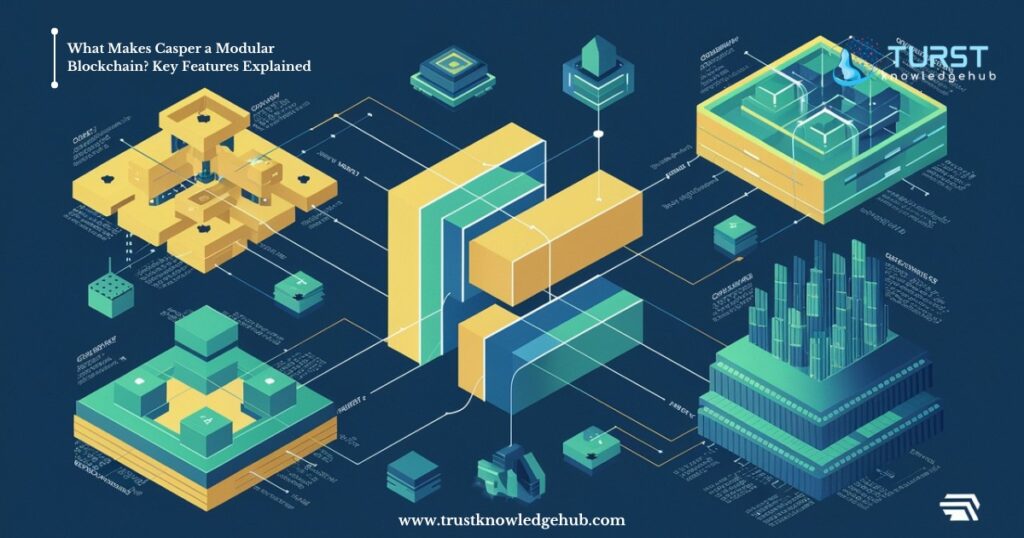In this article, readers will gain a thorough understanding of what makes Casper a modular blockchain by examining its innovative design features, including its scalable consensus mechanism and flexible architecture. We will explore how these elements address common blockchain challenges, offering insights into how Casper enhances performance and adaptability compared to traditional blockchain systems.
Introduction to Modular Blockchains
Understanding Modular Blockchain Architecture
Modular blockchain architecture represents a paradigm shift from traditional monolithic designs. Unlike conventional blockchains, which integrate all components into a single layer, modular blockchains separate functionality into distinct, interrelated layers. This separation allows each layer to specialize in a specific function, such as consensus, data storage, or smart contracts. By decoupling these elements, modular architectures enhance adaptability and scalability. They permit independent upgrades and improvements to individual components, fostering an environment where innovation can occur without disrupting the entire system.
The Evolution of Blockchain Technology
“Since its inception, blockchain technology has experienced considerable growth and transformation. Initially, blockchains were designed with a monolithic approach, where every node in the network had to process and validate all transactions, which limited scalability and flexibility. The advent of modular blockchains marks a crucial development, enabling blockchain systems to evolve into more scalable and adaptable structures. This evolution reflects a broader trend in technology towards increased specialization and efficiency, addressing the limitations of earlier blockchain designs and paving the way for more sophisticated and versatile applications.
Overview of Key Concepts in Modular Blockchains
Modular blockchains are underpinned by several key concepts. Central to this architecture is the notion of separation of concerns, where different aspects of blockchain functionality are handled by distinct modules. Core components include consensus mechanisms, which handle the agreement on transaction validity; data storage layers, which manage the blockchain ledger; and execution environments, where smart contracts and decentralized applications (dApps) operate. This modular approach allows for greater flexibility in adjusting or upgrading individual components without affecting the entire network, enhancing both scalability and performance.
Introduction to Casper Blockchain
Overview of Casper and Its Development
Casper is a leading example of a modular blockchain designed to address the limitations of earlier blockchain systems. Developed to provide a more scalable and secure alternative to traditional blockchains, Casper incorporates several innovative features. It was conceived as an Ethereum 2.0 upgrade but has since evolved into its independent platform. Casper introduces a Proof-of-Stake (PoS) consensus mechanism, enhancing energy efficiency and scalability compared to Proof-of-Work systems. Its development reflects a broader trend towards more sustainable and adaptable blockchain technologies.
Key Differences Between Casper and Traditional Blockchains
Casper distinguishes itself from traditional blockchains through its modular design and consensus mechanism. Traditional blockchains often rely on Proof-of-Work (PoW), which requires significant computational power and energy consumption. In contrast, Casper uses Proof-of-Stake (PoS), where validators are chosen based on their stake in the network, reducing energy consumption and increasing transaction throughput. Additionally, Casper’s modular approach allows for more flexible upgrades and improvements, whereas traditional blockchains typically require complete overhauls for significant changes.
The Role of Casper in the Blockchain Ecosystem
Casper plays a pivotal role in the blockchain ecosystem by providing a scalable and efficient platform that addresses many limitations of earlier blockchain systems. Its modular design and PoS consensus mechanism make it a viable choice for various applications, from financial services to decentralized applications. By offering a more sustainable and adaptable framework, Casper enhances the overall blockchain infrastructure, facilitating innovation and growth within the ecosystem.
Core Components of the Casper Blockchain

Casper’s Consensus Mechanism: Proof-of-Stake and Beyond
Casper’s consensus mechanism, Proof-of-Stake (PoS), is a departure from the energy-intensive Proof-of-Work (PoW) model. In PoS, validators are selected based on their stake in the network, which incentivizes them to act in the network’s best interest. This mechanism reduces the computational power required for transaction validation, leading to lower energy consumption and higher transaction throughput. Furthermore, Casper introduces advanced PoS variants that enhance security and scalability, setting it apart from traditional PoS implementations.
Smart Contracts and Their Role in Casper
Smart contracts are a fundamental component of the Casper blockchain. Smart contracts, which encode the terms of an agreement directly into their programming, facilitate automated and trust-free transactions. In Casper, smart contracts are designed to be more efficient and secure, leveraging the platform’s modular architecture to enhance performance. They facilitate a wide range of applications, from financial transactions to decentralized applications, by providing a reliable and transparent way to execute and enforce agreements.
The Importance of Layered Design in Modular Blockchains
The layered design in modular blockchains is crucial for enhancing flexibility and scalability. By separating different functions—such as consensus, data storage, and smart contract execution—modular blockchains can independently upgrade or modify each layer without disrupting the entire system. This design approach allows for more efficient management of resources, better adaptability to changing requirements, and improved performance. It also simplifies the integration of new technologies and features, fostering innovation within the blockchain ecosystem.
Modularity in Casper: An In-Depth Look
How Modularity Enhances Flexibility and Scalability
Modularity in Casper enhances flexibility and scalability by allowing each component of the blockchain to operate independently. This design enables easier updates and improvements to individual modules, such as the consensus mechanism or data storage layer, without affecting the overall system. Consequently, Casper can scale more effectively as it can handle increased transaction volumes and adapt to evolving demands without compromising performance. The modular approach also facilitates the integration of new technologies and innovations, ensuring that the blockchain remains adaptable and resilient.
Key Features of Casper’s Modular Approach
Casper’s modular approach includes several key features that set it apart from traditional blockchains. These features include a flexible consensus mechanism that can be adapted to different needs, a layered architecture that allows for independent updates, and enhanced scalability and performance. Additionally, Casper’s design supports interoperability with other blockchains and facilitates the development of complex decentralized applications. These features collectively contribute to a more versatile and efficient blockchain platform.
Comparison with Non-Modular Blockchain Systems
When compared to non-modular blockchain systems, Casper’s modular design offers several advantages. Non-modular blockchains often suffer from scalability issues and require complete overhauls for significant changes. In contrast, Casper’s modular approach allows for incremental improvements and adjustments, reducing downtime and maintaining system stability. The separation of concerns in modular systems also enables better resource management and more efficient performance, making Casper a more adaptable and future-proof solution.
Quorum Blockchain Development and Casper
Integrating Casper with Quorum Blockchain Development
Integrating Casper with Quorum blockchain development leverages the strengths of both platforms. Quorum, an enterprise-focused variant of Ethereum, provides a permissioned environment that enhances privacy and performance. By combining it with Casper’s modular and scalable framework, developers can create solutions that benefit from both advanced consensus mechanisms and enterprise-grade features. This integration facilitates the development of robust, scalable, and secure blockchain applications suitable for various industries.
Advantages of Combining Casper with Quorum Technology
The combination of Casper and Quorum technology offers several advantages. Casper’s modular design enhances Quorum’s scalability and flexibility, allowing for more efficient management of resources and easier updates. Additionally, Casper’s PoS consensus mechanism complements Quorum’s privacy features, providing a more energy-efficient and secure platform. This synergy enables the development of sophisticated blockchain solutions that meet the needs of both public and private networks, expanding the potential applications of blockchain technology.
Use Cases for Quorum and Casper Integration
The integration of Quorum and Casper can be applied to various use cases, including supply chain management, financial services, and decentralized applications. For instance, in supply chain management, the combined technologies can enhance transparency and traceability while maintaining data privacy. In financial services, the integration supports secure and efficient transaction processing. Additionally, decentralized applications can benefit from the scalability and flexibility provided by the integrated platform, enabling more complex and versatile solutions.
Scalability and Performance of Casper
How Casper Addresses Scalability Challenges
Casper addresses scalability challenges through its modular architecture and Proof-of-Stake consensus mechanism. By separating different functions and employing a more energy-efficient consensus model, Casper can handle a higher volume of transactions without compromising performance. The modular design also allows for the independent scaling of components, enabling the system to adapt to increasing demands effectively. This approach mitigates common scalability issues faced by traditional blockchains, providing a more scalable and resilient platform.
Performance Metrics and Benchmarks
Casper’s performance metrics and benchmarks reflect its advancements in scalability and efficiency. The platform boasts improved transaction throughput and lower latency compared to traditional blockchains, thanks to its modular design and PoS consensus mechanism. Benchmarking studies demonstrate Casper’s capability to handle high transaction volumes while maintaining system stability and security. These metrics underscore the platform’s suitability for a wide range of applications, from high-frequency trading to complex decentralized applications.
Real-World Applications Demonstrating Casper’s Scalability
Several real-world applications showcase Casper’s scalability and performance. In the financial sector, Casper has been used to develop scalable payment processing systems capable of handling high transaction volumes. In the realm of decentralized applications, the platform’s modular design has enabled the creation of complex dApps with high performance and reliability. These applications highlight Casper’s ability to deliver robust and scalable solutions across various industries, reinforcing its position as a leading blockchain platform.
Security Features of the Casper Blockchain
Security Protocols and Mechanisms in Casper
Casper employs several security protocols and mechanisms to ensure the integrity and safety of its blockchain. The platform’s Proof-of-Stake consensus mechanism, combined with cryptographic techniques, provides a secure environment for transaction validation and data protection. Additionally, Casper’s modular design includes built-in security features that protect against common vulnerabilities and attacks. These mechanisms collectively contribute to a secure and resilient blockchain platform, safeguarding both data and transactions.
The Impact of Modular Design on Security
The modular design of Casper positively impacts its security by isolating different functions into separate layers. This separation reduces the risk of systemic failures and vulnerabilities, as issues in one layer do not necessarily affect others. Furthermore, the modular approach allows for more targeted security enhancements and updates, addressing specific threats without disrupting the entire system. This design contributes to a more robust and secure blockchain platform, capable of adapting to evolving security challenges.
Case Studies: Security in Action
Case studies of Casper’s security in action demonstrate the platform’s effectiveness in real-world scenarios. For example, projects utilizing Casper’s security protocols have successfully thwarted attempted attacks and maintained data integrity. These case studies highlight the platform’s ability to provide a secure environment for various applications, from financial transactions to decentralized governance. The demonstrated security effectiveness reinforces Casper’s reputation as a reliable and secure blockchain solution.
Governance and Upgradability in Casper
Governance Models Supported by Casper
Casper supports various governance models, enabling flexible and adaptive management of the blockchain network. The platform incorporates on-chain governance mechanisms that facilitate decision-making and protocol upgrades. These models allow stakeholders to participate in governance processes, such as proposing and voting on changes to the protocol. The governance framework ensures that the network remains responsive to evolving needs and challenges, promoting long-term sustainability and innovation.
How Modular Design Facilitates Upgrades and Forks
Casper’s modular design facilitates upgrades and forks by isolating different components of the blockchain. This separation allows for independent updates to individual layers without disrupting the entire system. As a result, the platform can incorporate new features, improvements, or protocol changes more efficiently. The modular approach also simplifies the process of implementing hard forks, enabling smoother transitions and reducing the risk of network disruptions.
Examples of Governance Decisions and Their Impact
Examples of governance decisions in Casper illustrate the platform’s adaptability and responsiveness. For instance, past governance decisions have led to protocol upgrades that enhanced scalability and performance. These decisions, made through on-chain voting and stakeholder participation, demonstrate Casper’s ability to evolve and address emerging needs. The impact of these decisions underscores the importance of effective governance in maintaining a dynamic and resilient blockchain network.
Interoperability and Integration with Other Blockchains
How Casper Enhances Interoperability
Casper enhances interoperability by providing mechanisms for seamless integration with other blockchains. The platform’s modular architecture supports various interoperability protocols, enabling communication and data exchange between different blockchain networks. This capability facilitates the development of cross-chain applications and solutions, expanding the potential use cases for Casper and promoting collaboration within the blockchain ecosystem.
Integrating Casper with Existing Blockchain Networks
Integrating Casper with existing blockchain networks leverages the platform’s modular features and interoperability capabilities. By connecting with other networks, Casper can facilitate the transfer of assets and data across different blockchains, enhancing overall functionality and utility. This integration supports diverse applications, from multi-chain decentralized finance to cross-chain smart contracts, expanding the reach and impact of Casper’s technology.
Future Prospects for Cross-Blockchain Collaboration
The future prospects for cross-blockchain collaboration are promising, with Casper playing a pivotal role. As blockchain technology continues to evolve, the need for effective cross-chain solutions becomes increasingly important. Casper’s modular design and interoperability features position it well for future developments in cross-blockchain collaboration. The platform’s ability to integrate with various networks and support diverse use cases will likely drive innovation and expand the potential applications of blockchain technology.
Developing on the Casper Blockchain
Tools and Resources for Developers
Developers working with the Casper blockchain have access to a range of tools and resources designed to facilitate development. These include comprehensive SDKs, development environments, and documentation that support various aspects of blockchain development. Additionally, Casper provides community support and collaboration platforms, enabling developers to share knowledge and resources. These tools and resources streamline the development process and empower developers to create innovative solutions on the Casper platform.
Best Practices for Building on Casper
When building on the Casper blockchain, adhering to best practices is essential for success. Key practices include leveraging the modular architecture for scalable solutions, utilizing security protocols to protect data and transactions, and following established development guidelines for smart contracts. Additionally, staying informed about platform updates and participating in community discussions can enhance development efforts and ensure alignment with the latest advancements.
Examples of Successful Projects and Applications
Successful projects and applications on the Casper blockchain showcase its capabilities and potential. Examples include decentralized finance platforms, supply chain management solutions, and enterprise applications that leverage Casper’s scalability and modular design. These projects highlight the versatility of the platform and its ability to support diverse use cases, reinforcing its value as a development environment.
Comparing Casper with Other Modular Blockchains
Overview of Competing Modular Blockchains
Competing modular blockchains offer various features and capabilities that reflect the evolving landscape of blockchain technology. These include platforms like Polkadot, Cosmos, and Avalanche, each with its unique approach to modularity and interoperability. By examining these competing blockchains, one can gain insights into different strategies for addressing scalability, flexibility, and performance challenges within the blockchain ecosystem.
Strengths and Weaknesses of Casper Compared to Others
Casper’s strengths include its modular design, energy-efficient Proof-of-Stake consensus mechanism, and robust security features. However, compared to other modular blockchains, Casper may face challenges related to network adoption and integration with existing systems. Analyzing these strengths and weaknesses provides a comprehensive understanding of Casper’s position within the broader blockchain landscape and helps identify areas for potential improvement.
Case Studies Highlighting Differences
Case studies comparing Casper with other modular blockchains reveal distinct differences in performance, scalability, and application support. For example, projects utilizing Casper’s modular design may demonstrate superior scalability compared to competitors with more rigid architectures. These case studies offer valuable insights into the practical implications of different blockchain designs and highlight the unique advantages and limitations of Casper’s approach.
Future Prospects and Innovations in Casper
Upcoming Features and Enhancements
Casper is poised for continued innovation, with upcoming features and enhancements designed to further its capabilities. These may include improvements in scalability, new interoperability protocols, and advanced security mechanisms. Staying abreast of these developments is crucial for understanding the future trajectory of the platform and its potential impact on the blockchain ecosystem.
The Future of Modular Blockchains and Casper’s Role
The future of modular blockchains is likely to be characterized by increased specialization, enhanced interoperability, and greater scalability. Casper’s role in this future is significant, given its advanced modular design and innovative features. As the blockchain landscape evolves, Casper is well-positioned to contribute to and shape the direction of modular blockchain technology.
Predictions for Development and Adoption
Predictions for the development and adoption of Casper suggest continued growth and influence within the blockchain space. As organizations and developers seek scalable and adaptable solutions, Casper’s modular architecture and advanced features will likely drive its adoption across various industries. Future developments in the platform may further enhance its capabilities and solidify its position as a leading blockchain solution.
Conclusion
Recap of Key Features and Benefits of Casper
Casper’s key features include its modular design, Proof-of-Stake consensus mechanism, and robust security protocols. These elements contribute to its scalability, flexibility, and adaptability, making it a compelling choice for various applications. The platform’s ability to integrate with other blockchains and support diverse use cases further enhances its value within the blockchain ecosystem.
Final Thoughts on Casper’s Impact on Blockchain Technology
Casper represents a significant advancement in blockchain technology, offering solutions to many challenges faced by traditional systems. Its modular architecture and innovative features position it as a leading platform for scalable and secure blockchain applications. The impact of Casper on the blockchain landscape is profound, driving innovation and shaping the future of blockchain technology.
Encouragement to Explore Casper for Blockchain Development
Exploring Casper for blockchain development offers opportunities to leverage its advanced features and capabilities. Whether for enterprise solutions, decentralized applications, or innovative blockchain projects, Casper provides a robust and adaptable platform. Developers and organizations are encouraged to delve into Casper’s offerings and harness its potential to drive technological advancement and achieve their blockchain objectives.




